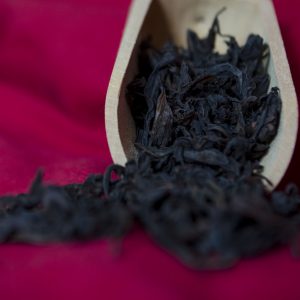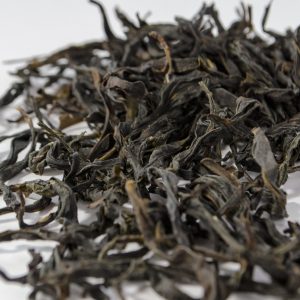Emperor’s New Robe
One of the famous Chinese ‘rock tea’ is Da Hong Pao, or Big Red Robe.
Meet Emperor’s New Robe.
But before we get into that let’s have a look at the legend behind Big Red Robe.
In the mountains a scholar took seriously ill on route to imperial exams and was forced to stay in Tian Xin Temple where monks helped restore his health by giving him some of the local tea.The scholar went on to pass his exam, some say he was actually the only one to pass and for this he got a large red robe. To thank the monks he presented them with the large red robe to cover the tea bushes and thus the tea received its name.Da Hong Pao is generally a blend nowadays, trying to mimic the taste of the mother bushes, the location of which are shrouded in secrecy.
One source that tells of Beidou to be ‘a first generation derivative plant type’, which is essentially a cultivar derived from the original Da hong pao plants. Most likely from a cutting.
Another source cites that Beidou cultivar was created in a laboratory. But before you get concerned, this is not unusual for tea.
The Taiwan Tea Research and Extension Station has developed many new tea cultivars or strains of tea plants; Jin Xuan being a well known example.
Da Hong Pao tends to be a blend nowadays, trying to mimic the taste of the original tea plants.
Just think that if either Beidou origin story is to be taken as true, this takes things to a new level.
Unblended single origin Beidou, meet Emperor’s New Robe.
It certainly lives up to expectations.
The dry leaf smells of toasted warm nuts, when wet the leaves release an amazing intense sweet chestnut aroma.
A gorgeous amber liquid fills the cup, and on first sip your senses are flooded with deep toasted flavours. So many flavour aspects to describe, there is a fantastic surprising sweet end note to this liquor.
The minerality of this tea lingers around the edges creating a lovely slightly sweet and lingering after taste.
Within all this, a floral note creeps in.
These leaves just keep on giving, the intense flavours do mellow slightly as you get further into the infusions, and the sweetness builds on your tongue.
How do I prepare this tea?
For Western style brewing
Use 2g of leaf to 300ml of water (china tea cup size).
Bring the water to boil, then pour over the leaves.
Infuse for approx 3 minutes.
Leaves used this way can be reused up to 4 times.
For Gong Fu or Chinese style brewing
Use 5g of leaf to 150ml of water (general gaiwan size).
Bring the water to the boil.
Then pour over the leaves, wait 10 seconds and decant your tea.
Leaves use this way can be reused at least 11 times. Yes, 11!
Just make sure to increase each subsequent infusion by 5 seconds.
These are intended as a guideline only, everyone is different.
We encourage you to play with different water temperatures and infusion times.
Store in a cool dry place away from sunlight.
Ingredients: Camellia Sinensis
Related products
-
Oolong Tea
Roasted Iron Goddess Oolong
£9.00 – £30.00 Select options This product has multiple variants. The options may be chosen on the product page -
Oolong Tea
Empress’ Gratitude 2018
£16.00 – £34.00 Select options This product has multiple variants. The options may be chosen on the product page -
White Tea
Celestial Jasmine
£11.00 – £38.00 Select options This product has multiple variants. The options may be chosen on the product page -
Oolong Tea
Duck Shit Oolong
£14.50 – £28.00 Select options This product has multiple variants. The options may be chosen on the product page






